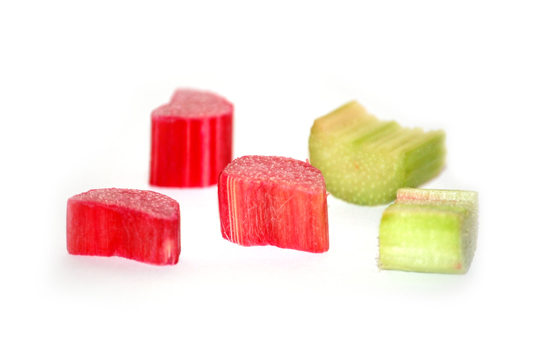
Reducing Food Waste in Foodservice
October 16, 2018 by Doreen Garelick, Dietetic Intern
Our intern Doreen attended a food waste summit for restaurants and compiled these tips to help food service operators redirect…
Nutrition 101
April 16, 2013

With rhubarb coming into season, Dietetic Intern Rebekah Facteau explains the nutritional benefits of this vegetable-turned-fruit.
If you haven’t come across it already, rhubarb -- along with many other spring fruits and vegetables -- will be showing up at your local farmers’ market soon, remaining in season through July. Originating in China where it was traditionally used to improve digestive health, rhubarb was first introduced to the US in the late 1700s by Benjamin Franklin. While it’s botanically a vegetable and part of the buckwheat family, it was declared a fruit in 1947 by a New York State court. Caught in a similar argument as the tomato, rhubarb was declared to be federally regulated as a fruit since it’s more often used as an ingredient in sweets, such as pies and jams.
When choosing your rhubarb, look for brightly colored stalks that are crisp and firm with minimal bruising. Rhubarb leaves should be removed once you bring them home, as they contain high amounts of oxalic acid making them unsafe to eat.
Rhubarb is one of those foods that people tend to shy away from at markets -- possibly because they don’t know what to do with it. Rhubarb, however, is rich in key nutrients and is delicious when utilized properly. Here are a few (nutritional) reasons why you shouldn’t pass it by this spring:
If you’re excited about adding rhubarb to your diet, try Senior Culinary Nutritionist Natalia Hancock's 200-calorie recipe for rhubarb custard!

October 16, 2018 by Doreen Garelick, Dietetic Intern
Our intern Doreen attended a food waste summit for restaurants and compiled these tips to help food service operators redirect food waste from landfills.
Nutrition 101

Nutrition 101
September 26, 2018 by Doreen Garelick, Dietetic Intern
Ever notice headlines about rapid weightloss? Dietetic Intern Doreen Garelick looks deeper into a recent eye-catching headline to see if there's any truth behind it.
Connect
 Follow us on Twitter
Follow us on Twitter Friend us on Facebook
Friend us on Facebook Follow us on Pinterest
Follow us on Pinterest Follow us on Instagram
Follow us on Instagram Read our Blog
Read our Blog Watch videos on YouTube
Watch videos on YouTube Watch videos on Vimeo
Watch videos on Vimeo Connect with us on Linkedin
Connect with us on Linkedin Find us on Foursquare
Find us on Foursquare
Tweets by @SPEcertifiedBlog Search
Categories
SPE Certified Newsletter
Sign up for news on the latest SPE-certified venues, events and SPE updates.
We will never share your personal information with a third party.